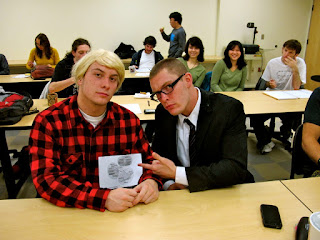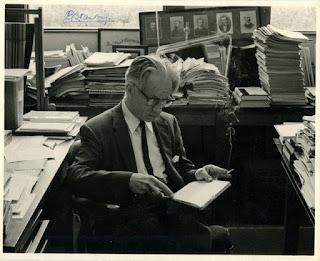Carl Woese has passed away.
84 is a long life, and it was well lived. But pancreatic cancer is an awful disease (it took another hero of mine, Randy Pausch, years ago). So once I heard that diagnosis, I knew that the outcome was seldom positive. At the same time, Woese did some remarkable things during his life, and the world is a poorer place without his example and polite refusal to intellectually "knuckle under" to convention or criticism (watch his video interview from 1998, linked below, and you will see what I mean: polite, driven, and devoted to the data). There is a saying that change can be evolutionary or revolutionary; the former is slow, while the latter is often bloody. It's also true in science, and in some ways, Carl Woese experienced both.
A quick glance at the entry in Wikipedia for Carl Woese shows that he had been honored with every major award a microbiologist could receive, short of the Nobel Prize. And many people, myself included, felt his contributions were sufficient to merit that recognition as well. Two eloquent voices I can point to on this topic are an editorial by Nature Reviews in Microbiology here, and Jon Eisen's well-reasoned essay here.
Woese is one of the names that I insist my students know and respect---not just in my microbiology course, but in my introductory cell and molecular biology course. And it is not simply about the Tree of Life, central and wildly important that it is to biology. It's also about the path to acceptance of the data that Carl Woese collected, and how he personally walked that path.
Woese's (and his coworkers') insight that the archaea are as different from bacteria as bacteria are different from eukaryotes, was fundamental, and not universally accepted at first. In fact, Woese experienced several eminent scientists disagree with him quite forcefully regarding the Three Domains model, including Salvador Luria and the formidable Ernst Mayr. The long term disagreement between some of these scientists and Woese was not altogether professional from time to time, and that aspect of the paradigm shift clearly had an effect on Woese. When I met Carl Woese at Woods Hole in the late 1990s, and burbled on enthusiastically about his work, he was polite but distant. Given what happened to him during that period of time, who could blame him?
Still, I am reminded of J.B.S. Haldane's waggish but too-often sadly accurate description (page 464) of how science progresses, in stages:
"Theories have four stages of acceptance. i) this is worthless nonsense; ii) this is an interesting, but perverse, point of view; iii) this is true, but quite unimportant; iv) I have always said so."A former undergraduate student of mine, Micheline Wong, actually added a fifth stage: "And I came up with the idea first." She was awfully young to be that cynical, but Micheline was not wrong; I have seen that "evolution" occur among scientists several times over the years.
So I deeply admire Carl Woese's work, and the philosophy and unwavering drive behind that work. Like Peter Mitchell and Lynn Margulis, Woese had an idea, and the data to back it up. When resistance was encountered, he just continued to work, filling in gaps, and evaluated each data set as he collected it. It is true that Margulis and Mitchell, from time to time, would advance, um, unusual ideas. But that never took away from their great accomplishments, I would contend: the chemiosmotic theory of bioenergetics is awfully important to all of biology, as are the endosymbiotic orgins of mitochondria and chloroplasts. In a similar fashion, Carl Woese had some iconoclastic ideas about what he called "pre-Darwinian" evolution. Based on his track record, I tend to think very, very carefully about anything that Carl Woese wrote; his insights are unique.
I would also like to draw your attention to Jon Eisen's analysis of Woese's original journal articles that explored the possibility of a Third Domain of life: the archaea. Eisen believes that the 1977 article by Woese may be one of the most important papers in the history of microbiology, and I can see his point. Read his essay over and see if you agree.
Let me be clear for a moment: I don't feed at a high trophic level in science; I am mostly an educator who dabbles a bit in research with undergraduates (and tries to groom such students for PhD programs). There will be far more eloquent and wiser heads than mine eulogizing this remarkable man's contribution to the biological sciences. But I cannot emphasize the centrality of the paradigm shift the work of Carl Woese created: it has fundamentally changed the way we looked at the relationships between all living things. And in so doing, it created the backdrop necessary for so much of the current furious ferment in microbiology.
But please don't take my word for it. Quite a while ago (14 years!), the American Society for Microbiology and the Public Broadcasting Service (along with the Department of Energy and National Science Foundation) put together a genuinely great video series about microbiology. I assign various segments of this series to my microbiology students each year. The series title "Intimate Strangers," the Enya-style soundtrack, and unfortunately near-soporific narration, sometimes make my students roll their eyes when they think I am not looking. But in particular, I have them watch, and we discuss, the segment detailing the contributions that Carl Woese has made to biology.
You can view the video here. There are wonderful comments and insights given by Norman Pace, as well as Carl Woese himself, who describes how he went about creating the data set which turned into the Tree of Life (and how he felt about doing so---the all-encompassing drive to complete the puzzle). Even the irrepressibly enthusiastic Karl Stetter speaks out. Norm Pace, at one point, opines that Carl Woese has done as much for the study of biology as Charles Darwin.
Personally, I think there is a case to be made for this point of view. Perhaps not many biologists think so now. But change is sometimes, as I wrote above, evolutionary. My money is on Carl Woese, as usual.
A final note. In last semester's Microbiology course, Carl Woese came up several times.
First, in a lovely "woolen sculpture" by Amy Wright of Carl Woese from an iconic photograph, along with a miniature blackboard complete with the Tree of Life. In the back is my favorite quote from Pliny the Elder. Roughly translated, it reads "Nature is to be found in Her entirety nowhere more than in Her smallest creatures.").
Second, Carl Woese appeared as a portrait "painted" with luminous bacteria (by my wife Jennifer Quinn) as part of my Microbial Hallowe'en this year:
And finally, on Hallowe'en proper, a student came to class dressed as Carl Woese (the other student is trying to look like another Microbial Hero™ of mine, C.B. van Niel).
So I think about the world of microbiology without Carl Woese, and I am sad. But I am reminded of the following passage, from the late Ray Bradbury's novel, Fahrenheit 451:
"Everyone must leave something behind when he dies...Something your hand touched some way so that your soul has somewhere to go when you die...It doesn't matter what you do, so long as you change something from the way it was before you touched it into something that's like you after you take your hands away."
So for me, I think about Carl Woese looking at the Five Kingdoms and other early taxonomic plans. And then I begin thinking about how he started puzzling together those spots of radioactive fragments of 16s rRNA on the autorads, assembling them by hand, bit by bit, into the Tree of Life with the Three Domains we all see today.
I will see Carl Woese's face in the metaphoric bark of that Three Domain Tree of Life, every time I look at it. I will see his face every time I teach it. I will make sure that my students see his face, too.
And to change the way we think about how all life is related is a fundamental, remarkable, and lasting legacy indeed.
Condolences to his family, friends, and colleagues.




































.jpeg)




















